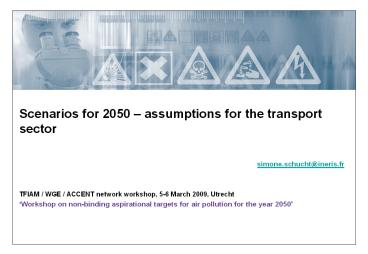Scenarios for 2050 - PowerPoint PPT Presentation
Title:
Scenarios for 2050
Description:
Simone Schucht /Mark Barrett. 1 / 18. Scenarios for 2050 assumptions for the transport sector ... Scenario run in SEEScen model by Mark Barrett ... – PowerPoint PPT presentation
Number of Views:50
Avg rating:3.0/5.0
Title: Scenarios for 2050
1
- Scenarios for 2050 assumptions for the
transport sector - simone.schucht_at_ineris.fr
- TFIAM / WGE / ACCENT network workshop, 5-6 March
2009, Utrecht - Workshop on non-binding aspirational targets for
air pollution for the year 2050
2
Introduction
- Scenarios analysed by Energy WG of the Centre
danalyse stratégique - Government demands high level commission to
develop major operational orientations and
suggestions for energy, transport and planning
policies - Objective
- ambitious assumptions but no technical and
behavioural breaks (fuel cells, hydrogen, limited
use of CCS, photovoltaics ...) - what would be needed to reach factor 4 CO2
reductions? - Baseline and aspirational scenarios analysed
- Exploratory analysis - these are no official
French scenarios
3
Introduction
- Scenario run in SEEScen model by Mark Barrett
- Use of some macro and transport data from
baseline scenario analysed by CAS Energy WG - 3 scenarios
- maximum technology
- maximum behaviour
- maximum technology and behaviour
4
Transport CO2 emissions (Mt CO2)
Analysed scenarios
Factor 1.7
Factor 3.5
gt Limited modal change, technology, efficiency
...
5
Modal change passenger transport (G p-km)
Analysed scenarios
Aspirational car share 83 in 2002, 75 in 2050
6
Modal change public transport (G p-km)
Analysed scenarios
Rail share BL 2025 67, aspirational 2050 71
Road share BL 2025 23, aspirational 2050 24
Air share BL 2025 10, aspirational 2050 5
7
Modal change freight transport (G t-km)
Analysed scenarios
Road share BL 2005 86, aspirational 2050 73
Rail share BL 2005 12, aspirational 2050 24
Rail share BL 2005 12, aspirational 2050 24
Inland water share BL 2005 2, aspirational
2050 4
8
Efficiency improvements
Analysed scenarios
- Average car performance (g CO2/km)
- Aircraft
- use of larger planes with more efficient engins
might reduce energy consumption per passenger-km
by a factor 2 between now and 2030 - Road freight - fuel consumption per v-km
- 2025 baseline and aspirational -15
- 2050 aspirational -30
9
Technology/fuels
Analysed scenarios
- Energy consumption of transport sector (M toe)
- Cars 2050
- ? 50 electric (urban/suburban) or hybrid
rechargeable - 45 of v-km using electricity
- petrol, diesel, bio-fuels ? 11 - 12 Mtoe
10
Further factors and drivers
Analysed scenarios
- Factors reducing fuel consumption
- Better capacity utilisation in road freight
transport - Eco-driving (cars and trucks)
- Car sharing
- Tele work
- Drivers
- Regulation
- Spatial planning
- Service poles (schools, commerce, health care
...) - Limitations to car use in central urban areas
- High occupancy vehicle lanes
- Increased public transport offer
- Increased prices for car use ( 50)
- High fuel prices ...
11
Passenger transport - maximum behavioural change
(G p-km)
SEEScen scenarios
12
Maximum technological and behavioural change
passenger transport by mode ()
SEEScen scenarios
13
Freight transport - maximum behavioural change (G
t-km)
SEEScen scenarios
14
Maximum technological and behavioural change
freight transport by mode ()
SEEScen scenarios
15
Maximum technological change passenger
transport (G v-km)
SEEScen scenarios
16
Transport (national) CO2 emissions (in M t CO2)
SEEScen scenarios
17
Conclusions
- Only indicative results
- Important is to identify possible trends and
important measures - Future?
- More detailed analysis and comparison of
assumptions in different scenarios/models - Analysis of further sectors
- Estimate effects on atmospheric emissions
18
Reports on the scenarios analysed by the CAS
working group http//www.strategie.gouv.fr/IMG/
pdf/Rapport_Energie_synthese_VOLUME_1.pdf http//w
ww.strategie.gouv.fr/IMG/pdf/Rapport_Energie_PARTI
E5.pdf Thank you!































